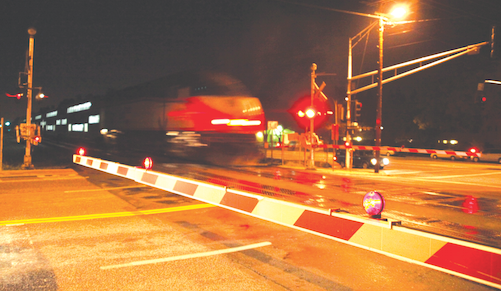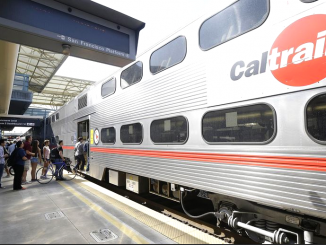
UPDATE, MONDAY, AUG. 9 — The Santa Clara County Medical Examiner-Coroner today identified the man killed on the Caltrain tracks in Palo Alto as Jacob Aaron Meisel, 23, of Stanford. He was killed Aug. 2 near the Palo Alto Avenue crossing.
Meisel was pursuing his bachelor’s and master’s degrees in electrical engineering when he died, according to Stanford.
Stanford sent out a campus-wide email on Wednesday saying Meisel had died but didn’t say that he had been killed by the train. “In honoring the family’s wish for privacy, we can only share that the cause was unrelated to COVID-19. We know this is difficult news to bear, especially at a time of great loss worldwide,” wrote Susie Brubaker-Cole, vice provost for student affairs.
“This morning, we are conveying this information to the entire campus so that we can share in consoling those who are grieving. Every life lost strikes a blow to the heart of our community, and the loss of such a young and promising person is especially sorrowful,” Brubaker-Cole wrote.
The campus-wide email then listed places people can go if they needed support.
FRIDAY, AUG. 6 — A Caltrain struck and killed a pedestrian in Palo Alto, circumventing a $1.5 million electronic detection system that is meant to alert police when people are on the tracks.
The coroner has not released the person’s identity, or whether it was an accident or a suicide. The strike occurred with a southbound train shortly after 10 p.m. Monday near the Palo Alto Avenue crossing, Lieberman said.
The city of Palo Alto has cameras with thermal sensors at four crossings, and spends about $300,000 a year for monitoring and maintenance. Two cameras are installed on Palo Alto Avenue, and four at Churchill Avenue, Meadow Drive and Charleston Road.
Vice Mayor Pat Burt said that City Manager Ed Shikada told him that the incident occurred where there is no electronic detection system. He didn’t know the exact location of the strike, so he couldn’t say whether it was outside of the range of the cameras, which see up to 1,000 feet down the tracks.
“No approach is failsafe, and that’s just the sad reality,” Burt said.
He also said the person who died was an adult.
Train safety and suicide received heightened attention in Palo Alto in 2009 after a series of teen suicides. Parents and volunteers began sitting out by the tracks in shifts, until the last train at 1 a.m. The guerrilla effort led the City Council to take action, and in 2009 the city took an unprecedented step to create a Track Watch program, with guards at the crossings for 24 hours a day.
The city contracted with Val Security, but residents criticized their guards for being unprofessional. Three of them were arrested, including one who was burglarizing homes while he was on the clock.
The contract was transferred to Cypress Security in June 2017 for $1.2 million a year.
The electronic system was seen as a less expensive and more permanent solution, and after a pilot at the Meadow Drive crossing, it was approved by the city council and implemented in 2018.
Both the San Mateo County Sheriff’s Office, which is handling the investigation, and the city of Palo Alto declined to release more information about the circumstances of the strike or why the cameras didn’t work, citing an ongoing investigation.
The system was developed by the CSC Integrations specifically to detect and deter suicides. The cameras are monitored and use artificial intelligence to detect people on the tracks, and then alert the Palo Alto police, who can relay the dispatch to the San Mateo County Sheriff’s transit police. A warning is also broadcasted onto the tracks.
“We are still reviewing what occurred, so it’s premature to draw any conclusions about the system’s performance,” city spokeswoman Jeanne Billeci said.
It was the sixth fatality on the tracks this year and the 54th death since 2017, Caltrain spokesman Dan Lieberman said.
ORIGINAL STORY ON MONDAY, AUG. 2 — A Caltrain hit a pedestrian tonight near the Palo Alto Avenue crossing in north Palo Alto.
No information was immediately available about who was hit. The incident happened at 10:22 p.m.
The train, SB192, was headed in the direction of San Jose.
Palo Alto police said the intersection is now closed. Police said the incident is the jurisdiction of the Transit Police Bureau of the San Mateo County Sheriff’s Office, and their personnel will handle the investigation and release any additional information.
For updates, visit www.twitter.com/CaltrainAlerts. No Twitter account is required; simply visit that page and refresh it as necessary.
Help is available
Anyone in crisis can get help from the Santa Clara County Suicide & Crisis Hotline at (855) 278-4204. Help is also available via Crisis Text Line (text HOME to 741741) or the National Suicide Prevention Lifeline at (800) 273-8255. All three services are free, confidential and available 24/7.




Why didn’t the Track Watch system stop this? Maybe we should go back to having parents watch the crossings for people who will get hit.
Was it a suicide or a person who was accidentally hit?
Sadly, thanks to forward-facing video cameras on all trains, it has long been known that essentially all pedestrians that put themselves into the path of oncoming Caltrains do so with obvious purpose. It turns out, that with all the signage and bells and whistles and flashing warning lights, it’s really not so easy to “accidentally” get hit by an oncoming train around here. Accidental deaths, while not impossible, are extremely rare.
Do you have any data to back that up?
Caltrain has records (and video recordings to defend against lawsuits). You can also check the FRA databases. If you’ve been paying close attention to Caltrain for the last 30 years, you can also consult your memory and/or just review archived news stories. The good news is that accidental deaths are extremely rare. The sad news is that suicides which have ranged from a handful to over 20 per year have proven to be difficult to prevent.
Why is Caltrain even operating right now? Sometimes there will be four or five people on a train. Shut it down, save the money and bring it back when demand returns. This is a huge waste of money,
Why didn’t stanford say he had taken his own life?
His family requested that his cause of death not be released. This article disobeys the family’s wishes.
Anonymous, do you believe there is a stigma associated with suicide? Should people be ashamed to talk about it, or to get the counseling they need? How does secrecy help people?
Isn’t the cause of death a public record in California?
Another company actually got the contract, not CSC according to the city’s records. According to a release by the city, G4S Secure Integration LLC won the contract and provides the service to monitor the cameras.
What a terrible waste of such a bright young mind.
This tragedy follows exactly 20 years after Stanford student Minna Sandmeyer took her life.
@BK Correct; anyone can get an unofficial but complete copy of the death certificate of any person who dies in the open records state of California. Certain states limit access to death certificates of their deceased to the deceased’s immediate family only.
The secrecy promotes the stigma associated with seeking help for mental health problems. Stanford should be open about this. The idea of silencing the discussion of suicide is something out of the 1950’s.